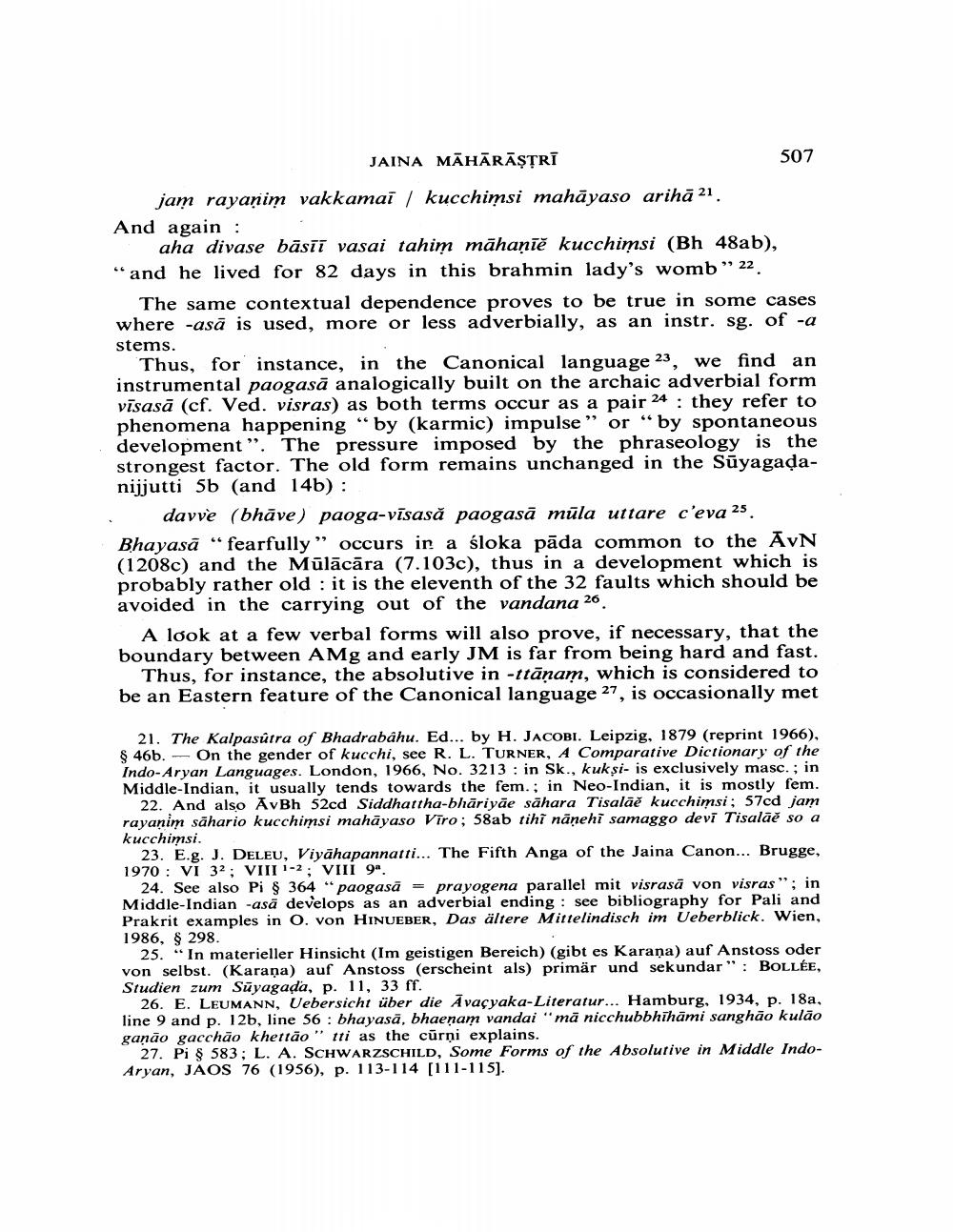________________
JAINA MĀHĀRĀȘTRĪ
507 jam rayaņim vakkamai / kucchimsi mahāyaso arihā 21. And again :
aha divase bāsīt vasai tahim māhanīě kucchimsi (Bh 48ab), "and he lived for 82 days in this brahmin lady's womb” 22.
The same contextual dependence proves to be true in some cases where -asā is used, more or less adverbially, as an instr. sg. of -a stems.
Thus, for instance, in the Canonical language 23, we find an instrumental paogasā analogically built on the archaic adverbial form vīsasā (cf. Ved. visras) as both terms occur as a pair 24 : they refer to phenomena happening "by (karmic) impulse” or “by spontaneous development". The pressure imposed by the phraseology is the strongest factor. The old form remains unchanged in the Sūyagadanijjutti 5b (and 14b): : davve (bhāve) paoga-vīsasă paogasā mūla uttare c'eva 25. Bhayasā “fearfully” occurs in a sloka pāda common to the AVN (1208c) and the Mulācāra (7.103c), thus in a development which is probably rather old : it is the eleventh of the 32 faults which should be avoided in the carrying out of the vandana 26.
A look at a few verbal forms will also prove, if necessary, that the boundary between AMg and early JM is far from being hard and fast.
Thus, for instance, the absolutive in -ttānam, which is considered to be an Eastern feature of the Canonical language 27, is occasionally met
21. The Kalpasútra of Bhadrabahu. Ed... by H. JACOBI. Leipzig, 1879 (reprint 1966), $ 46b. On the gender of kucchi, see R. L. TURNER, A Comparative Dictionary of the Indo-Aryan Languages. London, 1966, No. 3213: in Sk., kukşi- is exclusively masc. ; in Middle-Indian, it usually tends towards the fem. ; in Neo-Indian, it is mostly fem.
22. And also AvBh 52cd Siddhartha-bhāriyāe sähara Tisalāě kucchimsi; 57cd jam rayanim sähario kucchimsi mahāyaso Viro; 58ab tihi nānehi samaggo devi Tisalāě so a kucchimsi.
23. E.g. J. DELEU, Viyahapannatti... The Fifth Anga of the Jaina Canon... Brugge, 1970: VI 32; VIII-2; VIII 9.
24. See also Pi 364 “paogasā = prayogena parallel mit visrasā von visras"; in Middle-Indian -asă develops as an adverbial ending : see bibliography for Pali and Prakrit examples in O. von HINUEBER, Das ältere Mittelindisch im Ueberblick. Wien, 1986, $298.
25. "In materieller Hinsicht (Im geistigen Bereich) (gibt es Karaņa) auf Anstoss oder von selbst. (Karaņa) auf Anstoss (erscheint als) primär und sekundar": BOLLÉE, Studien zum Suyagada, p. 11, 33 ff.
26. E. LEUMANN, Uebersicht über die Āvaçyaka-Literatur... Hamburg, 1934, p. 18a, line 9 and p. 12b, line 56 : bhayasā, bhaenam vandai "mā nicchubbhīhāmi sanghāo kulāo ganão gacchão khetto" iti as the cūrņi explains.
27. Pi $ 583; L. A. SCHWARZSCHILD, Some Forms of the Absolutive in Middle IndoAryan, JAOS 76 (1956), p. 113-114 [111-115].




